 W
WByasa polyeuctes, the common windmill, is the most common member in India of the windmills genus (Byasa), comprising tailed black swallowtail butterflies with white spots and red submarginal crescents.
 W
WDanaus chrysippus, also known as the plain tiger, African queen, or African Monarch, is a medium-sized butterfly widespread in Asia, Australia and Africa. It belongs to the Danainae subfamily of the brush-footed butterfly family Nymphalidae. Danainae primarily consume plants in the genus Asclepias, more commonly called milkweed. Milkweed contains toxic compounds, cardenolides, which are often consumed and stored by many butterflies. Because of their emetic properties, the plain tiger is unpalatable to most predators. As a result, the species' coloration is widely mimicked by other species of butterflies. The plain tiger inhabits a wide variety of habitats, although it is less likely to thrive in jungle-like conditions and is most often found in drier, wide-open areas.
 W
WDanaus genutia, the common tiger, is one of the common butterflies of India. It belongs to the "crows and tigers", that is, the Danainae group of the brush-footed butterflies family. The butterfly is also called striped tiger in India to differentiate it from the equally common plain tiger, Danaus chrysippus. The species was first described by Pieter Cramer in 1779.
 W
WDelias descombesi, the redspot Jezebel is a medium-sized butterfly of the family Pieridae, that is, the yellows and whites.
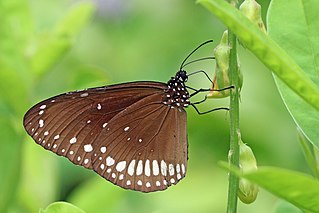 W
WEuploea core, the common crow, is a common butterfly found in South Asia to Australia. In India it is also sometimes referred to as the common Indian crow, and in Australia as the Australian crow. It belongs to the crows and tigers subfamily Danainae.
 W
WEurema hecabe, the common grass yellow, is a small pierid butterfly species found in Asia, Africa and Australia. They are found flying close to the ground and are found in open grass and scrub habitats. It is simply known as "the grass yellow" in parts of its range; the general term otherwise refers to the entire genus Eurema.
 W
WGraphium cloanthus, the glassy bluebottle, is a common, non-threatened tropical butterfly of the family Papilionidae.
 W
WGraphium doson, the common jay, is a black, tropical papilionid (swallowtail) butterfly with pale blue semi-transparent central wing bands that are formed by large spots. There is a marginal series of smaller spots. The underside of wings is brown with markings similar to upperside but whitish in colour. The sexes look alike. The species was first described by father and son entomologists Cajetan and Rudolf Felder.
 W
WHydrophilus caschmirensis, common name large scavenging water beetle, is a species of water scavenger beetle belonging to the family Hydrophilidae.
 W
WHypermnestra helios is a species of swallowtail butterfly belonging to the Parnassinae family and is the sole member of the genus Hypermnestra. It is found in Iran, Afghanistan, Pakistan, Turkmenistan, Kirghizstan, Tajikistan, and Uzbekistan. It is locally common in desert habitats.
 W
WOmorgus granulatus is a beetle of the family Trogidae found in India, Pakistan, and Afghanistan.
 W
WPapilio (Chilasa) agestor, the tawny mime, is a swallowtail butterfly, native to Indian subcontinent and widely found across Asia. The butterfly belongs to the mime subgenus, Chilasa, of the genus Papilio or the black-bodied swallowtails.
 W
WPapilio alexanor, the Alexanor or southern swallowtail, is a butterfly species in the Papilionidae or swallowtails.
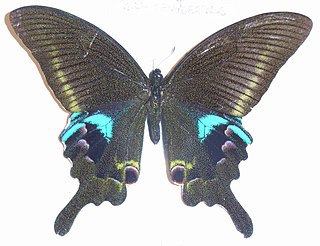 W
WPapilio arcturus, the blue peacock, is a species of swallowtail butterfly found in the Indian subcontinent.
 W
WPapilio clytia, the common mime, is a swallowtail butterfly found in south and southeast Asia. The butterfly belongs to the subgenus Chilasa, the black-bodied swallowtails. It serves as an excellent example of a Batesian mimic among the Indian butterflies.
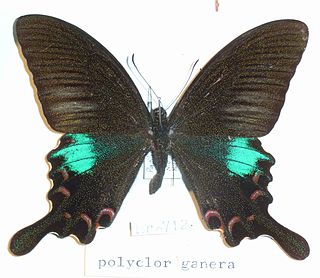 W
WPapilio polyctor, the common peacock, is a swallowtail butterfly found in the Indian subcontinent. It is found in the Himalayas and parts of India from the foothills to 7,000 feet (2,100 m) between March and October. It has distinct dry- and wet-season forms. The butterfly frequents Buddleia flowers. Its food plant is Xanthoxylon alatum of the family Rutaceae. Papilio polyctor has three subspecies, consisting of Papilio polyctor significans, Papilio polyctor stockleyi, and Papilio polyctor xiei.
 W
WPapilio polytes, the common Mormon, is a common species of swallowtail butterfly widely distributed across Asia.
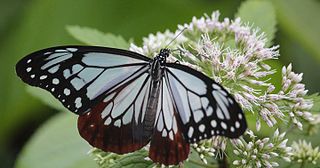 W
WParantica sita, the chestnut tiger, is a butterfly found in Asia that belongs to the crows and tigers, that is, the danaid group of the brush-footed butterflies family.
 W
WParnassius acco, the varnished Apollo, is a high-altitude butterfly found in Asia. It is a member of the snow Apollo genus Parnassius of the swallowtail family, Papilionidae.
 W
WParnassius actius, also known as the scarce red apollo, is a high-altitude butterfly found in Central Asia. It is a member of the snow Apollo genus (Parnassius) of the swallowtail family (Papilionidae).
 W
WParnassius charltonius, the regal Apollo, is a high-altitude butterfly which is found in India. It is a member of the snow Apollo genus (Parnassius) of the swallowtail family (Papilionidae). This handsome butterfly is found at altitudes from 9,000 to 13,000 feet from Chitral to Kumaon.
 W
WParnassius delphius, the banded Apollo, is a high-altitude butterfly which is found in Central Asia. It is a member of the genus Parnassius of the swallowtail family, Papilionidae.
 W
WParnassius epaphus, the common red Apollo, is a high altitude butterfly which is found in India and Nepal. It is a member of the snow Apollo genus (Parnassius) of the swallowtail family (Papilionidae). This handsome butterfly is found from 9,000 to 13,000 feet from Chitral District to Sikkim and western regions of Nepal. It is not considered rare.
 W
WParnassius hardwickii, the common blue Apollo, is a high-altitude butterfly which is found in South Asia. It is a member of the snow Apollo genus (Parnassius) of the swallowtail family (Papilionidae). This butterfly is found from the Chitral District to Sikkim and is found from 6,000 to 17,000 feet, making it one of the most commonly encountered species of Apollo in the Indian subcontinent.
 W
WParnassius jacquemontii, the keeled Apollo, is a high altitude butterfly which is found in India and Pakistan. It is a member of the snow Apollo genus (Parnassius) of the swallowtail family (Papilionidae). It is also fairly common at high altitudes from Chitral to Kumaon.
 W
WParnassius simo, the black-edged Apollo, is a high-altitude butterfly found in the Himalayas which belongs to the Papilionidae (swallowtail) family.
 W
WParnassius staudingeri is a high-altitude butterfly which is found over a vast area - Pamirs, Altay Mountains, Hindu Kush, Karakorum and west Kuen-Lun.
 W
WPhalanta phalantha, the common leopard or spotted rustic, is a sun-loving butterfly of the nymphalid or brush-footed butterfly family.
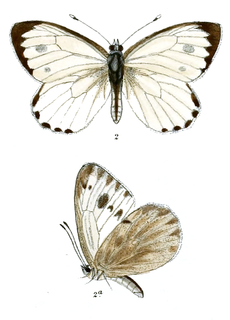 W
WPieris deota, the Kashmir white, is a small butterfly of the family Pieridae, that is, the yellows and whites, which is found in India, Pakistan, Tibet, and central Asia. It is found in the north-western Himalayas in Ladakh at 760 m (2,490 ft) and in Tibet and the Pamirs, at altitudes of 3,700–4,300 m (12,100–14,100 ft).
 W
WSaga pedo is a species of bush cricket, spread throughout the European part of the Mediterranean, and Asia as far east as China. It is a wingless bush cricket, with the body size of up to 12 centimetres (4.7 in), which makes it one of the largest European insects and one of the world's largest Orthoptera. Colloquially known as the predatory bush cricket, or the spiked magician, it is uncommon among its kind due to its carnivorous lifestyle, most often preying on smaller insects, with a known tendency towards cannibalism as well. For this purpose, it has strong fore and mid legs, equipped with sharp spines. When these animals are hunting, they move about, catching their prey by suddenly leaping on them and grabbing them with their legs. Their prey is usually killed by biting into the throat, and eating is done at capture. Saga pedo is active at dusk and during nighttime, with activity slowly expanding through the day at the end of the season.
 W
WTarucus callinara, the spotted Pierrot, is a small butterfly found in India that belongs to the lycaenids or blues family found in India, Myanmar and Thailand.
 W
WTirumala limniace, the blue tiger, is a butterfly found in South Asia and Southeast Asia that belongs to the crows and tigers, that is, the danaid group of the brush-footed butterfly family. This butterfly shows gregarious migratory behaviour in southern India.
 W
WVespa tropica, the greater banded hornet, is a tropical species of hornet found in Southern Asia, New Guinea and west Africa, and which has recently been discovered to be an invasive species on the Pacific island of Guam. It is a predator of paper wasps and possesses a potent sting, which can cause extreme pain and swelling.
 W
WXylocopa valga is a species of carpenter bee common to: western, central and southern Europe, except for far northern latitudes; the Caucasus; Middle East; Central Asia; and Mongolia. The solitary bee has a black and blue coloured body, 20–27 mm in length, and densely covered with purple hairs. The small wings also have a purple tint. The bee creates cavity nests by gnawing the wood in the trunks of dead trees and in old wooden structures. It inhabits both forests and urban areas.
 W
WXylocopa violacea, the violet carpenter bee, is the common European species of carpenter bee, and one of the largest bees in Europe. It is also native to Asia.